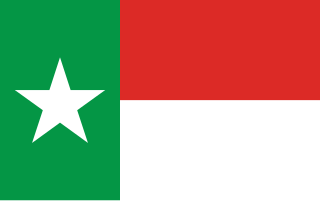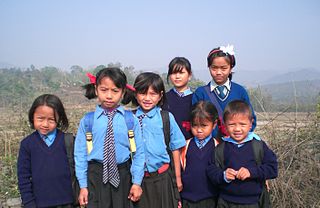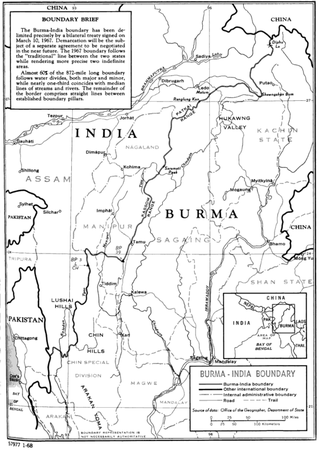Related Research Articles

The National Liberation Front of Tripura was a banned Tripuri nationalist terrorist organisation based in Tripura, India. It had an estimated 550 to 850 members.

The Indigenous Nationalist Party of Twipra was a political party in the Indian state of Tripura. Bijoy Kumar Hrangkhawl was the President of the party. It merged with the Tipraha Indigenous Progressive Alliance (TIPRA) party on 11 June 2021.

The National Democratic Front of Boroland (NDFB) was an armed separatist outfit which sought to obtain a sovereign Boroland for the Bodo people. It is designated as a terrorist organisation by the Government of India.

The Insurgency in Northeast India involves multiple separatist militant groups operating in some of India's northeastern states, which are connected to the rest of India by the Siliguri Corridor, a strip of land as narrow as 14.29 miles (23.00 km) wide.

Terrorism in India, according to the Home Ministry, poses a significant threat to the people of India. Compared to other countries, India faces a wide range of terror groups. Terrorism found in India includes Islamist terrorism, ultranationalist terrorism, and left-wing terrorism. India is one of the countries most impacted by terrorism.
Tripura National Volunteers was a Tripuri nationalist militant group in the Tripura region of India that launched an armed struggle in the early 1980s to separate Tripura from India. TNV was led by Bijoy Kumar Hrangkhawl.

The All Tripura Tiger Force (ATTF) was a Tripuri nationalist militant group active in India's Tripura State. It was founded on 11 July 1990, by a group of former Tripura National Volunteer members under the leadership of Ranjit Debbarma. The ATTF is considered a terrorist organisation by India. According to the South Asian Terrorism Portal, approximately 90% of the ATTF's administration are Hindu and the rest are Christians. The group was said to have been formed as the armed wing of the National Liberation Front of Tripura (NLFT) but split into its own organization. The group was headquartered in Tarabon in Bangladesh.

Assam separatist movements refers to a series of multiple insurgent and separatist movements that had been operated in the Northeast Indian state of Assam. The conflict started in the 1970s following tension between the native indigenous Assamese people and the Indian government over alleged neglect, political, social, cultural, economic issues and increased levels of illegal immigration from Bangladesh. The conflict has resulted in the deaths of 12,000 United Liberation Front of Assam (ULFA) militants and 18,000 others.
Secession in India typically refers to state secession, which is the withdrawal of one or more states from the Republic of India. Whereas, some have wanted a separate state, union territory or an autonomous administrative division within India. Many separatist movements exist with thousands of members, however, some have low local support and high voter participation in democratic elections. However, at the same time, demanding separate statehood within under the administration of Indian union from an existing state can lead to criminal charges under secession law in India. India is described as an ‘Union of States’ in Article 1 of the Indian constitution I.e "Indestructible nation of destructible states" by its father of constitution Dr. Bhimrao Ramji Ambedkar where a state or Union territory of India cannot secede from India by any means and the Central Government has more powers than the respective state governments and can forcefully change the names and boundaries of the states without their permission at any time when needed for self interest and for the maintenance of integrity.
Kamalnagar massacre refers to the murder of 14 unarmed Bengali Hindu villagers in Kamalnagar on 14 August 2003 by the All Tripura Tiger Force insurgents.

The Insurgency in Meghalaya is a frozen armed conflict between India and a number of separatist rebel groups which was taking place in the state of Meghalaya. The Insurgency in Meghalaya is part of the wider Insurgency in Northeast India, and was fueled by demands of the Khasi, Synteng and Garo people for a separate state.
Operation Roukhala was an ethnic cleansing operation launched by the All Tripura Tiger Force (ATTF) for the eviction of Bengali Hindus from Tripura in the late 1990s and early 2000s. The word Roukhala in Kokborok literally means ouster or deportation or driving out. In the early stages of the movement, the ATTF and the National Liberation Front of Tripura (NLFT) separately issued quit notices to the Bengali Hindus. The ATTF named it as Operation Roukhala. Later NLFT joined the movement. According to the political leaders in Tripura, the rebels resort to abduction and murder of non-tribals in the Tripura Tribal Areas Autonomous District Council (TTAADC) area as a part of Operation Roukhala.

The insurgency in Tripura was an armed conflict which took place in the state of Tripura between India and several separatist rebel organisations. It was a part of the wider insurgency in Northeast India and was fueled by Tripuris.
United Bengali Liberation Front was a militant separatist organisation in Tripura, India. It sought to protect Bengalis from Bangladesh against Tripuri militants and other tribal groups and first appeared in the year 1995, alongside the NLFT and ATTF. There was no official data about its commanders and cadres. UBLF was involved in bomb blasts, murders and Hostage Crises. Its conflict was against Indigenous Tribals and other Tribals of Neighbouring stares. The UBLF came into existence only after the ATTF was formed with the aim of decimating Bengali Hindus living in Tripura. The ATTF carried out multiple attacks against the Bengali Hindus who arrived to India after ethnic cleansing in Bangladesh. The ATTF have been credited with at least 20 attacks on Bengali speaking people. The formation of UBLF was a direct retaliation against these killings of Bengali Hindus.The UBLF was banned by the GoI later.

The hill tribes of Northeast India are hill people, mostly classified as Scheduled Tribes (STs), who live in the Northeast India region. This region has the largest proportion of scheduled tribes in the country.
Anti-Bengali sentiment comprises negative attitudes and views on Bengalis. This sentiment is present in several parts of India: Gujarat, Bihar, Assam, and various tribal areas. etc. Issues include discrimiation in inhabitation, other forms of discrimination, political reasons, government actions, anti-Bangladeshi sentiment, etc. The discriminative condition of Bengalis can be traced from Khoirabari massacre, Nellie massacre, Silapathar massacre, North Kamrup massacre, Goreswar massacre, Bongal Kheda, etc. This has led to emergence of Bengali sub-nationalism in India as a form of protest and formation of many pro-Bengali organisations in India.

Throughout the long-running separatist insurgencies in Northeast India, dozens of India-based insurgent groups have been involved in the neighboring conflict in Myanmar, both sheltering in Myanmar from the counterinsurgent Assam Rifles and participating in the conflict itself. Outside of several Indian-led operations, including Operation Golden Bird in 1995, Operation Hot Pursuit in 2015, or Operation Sunrise I and II in 2019, areas in which these insurgent groups are active have scarcely experienced fighting. Amid the escalation of civil war in Myanmar from 2021, several sources claim that the majority of Indian ethnic armed organisations (IEAOs) are allied, or have some level of understanding, with the ruling military junta of Myanmar, who allows them to maintain bases inside mountainous areas of northern Myanmar, typically in return for the IEAOs attacking anti-junta resistance groups.
Dhananjay Reang is a Tripuri (Bru) rebel leader of the organisations National Liberation Front of Tripura, and Tripura National Volunteers (TNV).
References
- ↑ Bhattacharyya, Harihar (1989). "The Emergence of Tripuri Nationalism, 1948-50". South Asia Research. 9 (1): 54–71. doi:10.1177/026272808900900104. S2CID 144382077.
- ↑ Barma, Aloy Deb (2024). "Talking Back through Peripheral Visions and Negotiating Identity: Kokborok and Bengali Films and Music Videos in Tripura". Journal of Film and Video. 76 (2): 33–48. doi:10.5406/19346018.76.2.05. ISSN 1934-6018.
- ↑ Das, Samir Kumar (2005), Peace Processes and Peace Accords, SAGE Publications, p. 204, ISBN 978-0-7619-3391-5
- 1 2 "National Liberation Front of Tripura". South Asia Terrorism Portal.
- ↑ "All Tripura Tiger Force". South Asia Terrorism Portal.
- ↑ "Constitution of The National Liberation Front Of Tripura". South Asia Terrorism Portal.
- ↑ "India: Tripura Terror Assessment For Year 2013 – Analysis". Eurasia Review. 11 December 2012.